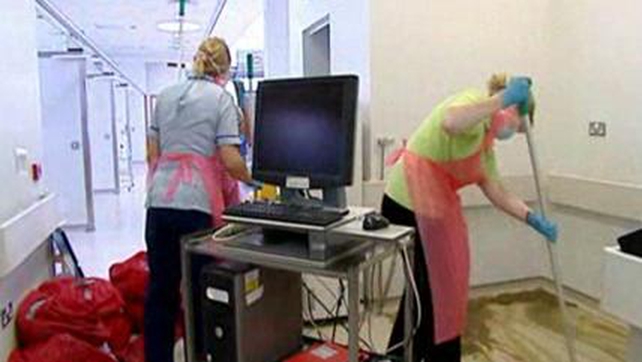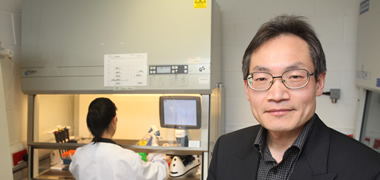Free under 6s GP care dubbed a precedent to change doctor’s conditions
The IMO said a new draft contract for the initiative would mean a significantly increased workload for doctors and would require additional resources.
The IMO has accused the government of using the extension of GP cards to children under the age of six to push through radical reform.
Following an initial review of the draft contract proposed by the government in relation to the initiative, the organisation said it has “serious concerns”.
Ahead of the publication of the contract, government officials met with GP representatives but the IMO accused the government of pushing “spin over substances” afterwards.
Today, Dr Ray Walley, Chairman of the GP Committee of the IMO claimed the initiative was a “trojan horse” aimed at reforming the terms and conditions of doctors dealing with public patients without any negotiation.
Speaking today, Dr.Walley suggested that the proposals will:
• Significantly increase clinical workload;
• Increase the number and complexity of consultations;
• Seriously undermine the clinical independence of General Practitioners;
• Require additional resources in infrastructure, staffing levels (both medical and administrative);
• Impose a range of new responsibilities on GPs.
Over the coming weeks the IMO will provide an analysis of the proposals to members so they can assess the impact it will have on them.
“The manner in which the government is seeking to impose these significant changes is neither acceptable nor practical and there are serious issues about the sustainability of the current model of General Practice which is the cornerstone of our health services,” Walley said. “We can and want to do more but only with planning and adequate resources. We call upon government to immediately commence real negotiations.”
Irish parents not guiding girls into science and technology


GIRLS AREN’T BEING PUSHED INTO SCIENCE
THE poor uptake by girls of study in science, technology and engineering may be partly because parents feel ill-equipped to advise them on the new world of work.
Parents are the biggest influencers of their daughter’s career choice, but could lack the knowledge to guide them into the increasing number of jobs requiring these skills, according to a new report.
Gender stereotyping remains a major obstacle to attracting more females, with many taking the view that such areas are better suited to males.
The ‘Attracting More Young Women into Science and Technology’ report is part of an initiative to ensure that Ireland has enough suitably qualified people to attract industries.
Hi-tech companies in Ireland and elsewhere struggle to find enough graduates, male or female, for the science and technology-based careers of the future – but women are vastly under-represented.
A government expert group estimates that 44,500 job opportunities will open for people with high-level information and communications technology (ICT) skills over the next six years and there are fears that many will go unfilled.
The report by consultants Accenture states that it is disappointing to think that a significant number of schoolgirls are closing themselves off to careers based on often outdated or incorrect perceptions.
Risk factor linked to schizophrenia identified by Galway scientist
Professor Sanbing Shen (above) of the Regenerative Medicine Institute (REMEDI) at NUI Galway has led a multi-institutional study which has identified a novel rare risk factor linked with mental illnesses such as schizophrenia.
Little known gene essential for brain development
A joint research team led by an NUI Galwayscientist has found that changes in a little-known gene called ULK4 were observed in individuals with schizophrenia.
A rare risk factor which is associated with mental illnesses like schizophrenia has been identified by a joint research team led by an NUI Galway (NUIG) scientist. The research team has found that changes in a little-known gene called ULK4 were observed in individuals with schizophrenia.
Prof Sanbing Shen of NUIG’s Regenerative Medicine Institute, who led the research, says that this could contribute to more effective treatment of the condition in time. The multi-institutional study examined a database of up to 7,000 people, half of whom had schizophrenia and half of whom did not.
Many genetic risk factors have been associated with schizophrenia and other mental illnesses such as bipolar disorder and depression, but Prof Shen and his team were able to characterise how the ULK4 gene functions in the brain.
He and his colleagues found that when levels of ULK4 were decreased, through mutation or deletion, the neuronal (brain) cells tend to function less well.
This leads to reduced synaptic function and other changes that are also known as risk factors of schizophrenia. Prof Shen said ULK4 is essential for the formation of the nerve fibres which connect the two sides of the brain. “It mainly interferes with brain development, but is it also a very important gene in that it has been identified as a risk factor for tumours, multiple myeloma, heart disease and high blood pressure,
“When both copies of this gene are removed, it can cause fatal effects such as hydrocephalus, and when one copy is removed it can cause mental illness,” Prof Shen said.
The findings were supported by genetic data provided by the International Schizophrenia Consortium.
They were confirmed by using new data generated from other illness groups, including autism, major depression and bipolar disorder.
Prof Shen said he hoped more research would lead to a better understanding of the condition, and how drugs may be developed to target ULK4 for the treatment of mental illness.
The research was funded by Science Foundation Ireland, NUIG, the Cunningham Trust, Scottish Universities Life Sciences Alliance, Medical Research Scotland and the University of Aberdeen.
Sligo and Letterkenny General hospitals warned of serious hygiene risks


Sligo General Hospital and Letterkenny General Hospital and were among 13 hospitals which received formal warnings from a health watchdog about serious risks to patients after hygiene inspections.
The warnings to the hospitals were issued in the last 14 months after HIQA inspectors made announced and unannounced inspections to 49 hospitals around the country.
According to the Irish Independent, inspectors had to make return visits to seven hospitals, including Letterkenny and Sligo General.
The notifications of risk to the 13 hospitals involved cleanliness, hand washing and control of infectious diseases that posed a risk to patients.
Phelim Quinn, HIQA’s director of regulations said: “We noted that most of those hospitals that required a second inspection had improved and generally the feedback from the hospitals demonstrates a positive and constructive attitude to the recommendations.”
Health and Wealth: the questions put to Tánaiste Gilmore today


Eamon Gilmore was quizzed on why health insurance is going through the roof and if the rich were getting richer.
Six thousand Irish people a month are falling out of private health insurance, according to Fianna Fáil Health spokesperson Billy Kelleher who was speaking in the Dáil this afternoon.
He was questioning Tánaiste Eamon Gilmore on what was being done to help the families who can no longer afford health insurance as premiums continue to rise.
The Labour party leader responded by saying that he shares the wonder that people have that prices are up and not down, “at a time of of increased competition and new players in the market.
He noted that the government has “no legal power to intervene in the prices” but claimed it is “very concerned about the cost of standard health insurance for hard pressed families”.
“That is why Minister for Health Doctor James Reilly set up a consultative forum to work on the issue of containing costs,” he added.
He told Kelleher that work has moved into the second phase – of studying the key drivers of increasing prices in greater depth. He outlined some of the recommendations that have been made by the report so far:
• Adopting a coordinated approach to identifying and tackling fraud in the industry and that it should publicly release data on funds recovered from hospitals and consultants;
• Calls on the industry to fund a whistleblowers’ initiate to assist in uncovering fraud;
• Addressing the age structure of the private health insurers market by encouraging younger people to take up insurance;
• The industry can make better use of legislation by discounting students under the age of 23.
Kelleher responded by saying:
We appreciate you sharing the wonder but we would much rather you share the responsibility of the escalating costs.
He outlined that “every family in this county will be affected by the cap on tax relief”, asking if the Tánaiste would “reverse the cap on tax relief and bring in some model that will attract young people back into the health insurance market before it crumbles?”
Gilmore replied that there is a problem, the government is taking it seriously and that is why an initial report has been concluded and further study being undertaken.
He added, “I don’t understand why a health insurance company should get a bill for €17,000 for one night in hospital. I don’t understand that and I think that is one of the issues that we have to get to the bottom of.”
Rising health insurance costs…is not a new phenomenon, its been with us for quite a while and this government is determined that it’s going to get to the bottom of what is driving the rising costs of health insurance and try to get that under control for families who are under pressure in relation to paying it.
Wealth: The Tánaiste was also questioned by TD Seamus Healy on disproportionate wealth in Ireland:
The policies of governments have allowed a golden circle of the rich and powerful in this country to maintain obscene amounts of wealth while the vast majority have seen their incomes reduced and struggle day in and day out to make ends meet.
“Irish society is and is becoming more and more unequal…that’s the message coming from Davos, Oxfam, CSO and also the message coming from Irish Waters huge payments to consultants.”
“The Paris school of economics in a recent study showed that 1 per cent of the wealthiest people in Ireland own 7 per cent of national income.
Accumulated wealth is even more stark with 5 per cent of the wealthiest families in this country owning 47 per cent of the wealth.
“During the recession the wealthiest 10 per cent of people in this country have seen their incomes rise.”
Gilmore responded by saying the “the top 1 per cent of earners in this country now pay around 20 per cent of the income tax and the top 5 per cent now pay around 40 per cent of all the income tax that’s paid in this country.”
He added: “The OECD now believe the tax system in Ireland is one of the most progressive in the OECD system.”
Healy then asked Gilmore to withdraw water taxes, quoting the Tánaiste himself opposing water charged in 1997, saying:
Water charges were a form of double taxation and the government were right to abolish them.
“There are three essential forms of wealth: property, pensions and money and that on all of those three areas of wealth, this government has issued extra taxes,” responded Gilmore.
In relation to the issue of water, he said:
We have made it clear there will be a charging system on water, there will be a free water allowance but that charging for water will be on a metered basis beyond that free allowance
Rare Kemp’s Ridley Atlantic turtle discovered on a Devon beach

The warm water reptile was found dead on the sand
A rare warm water turtle washed up on a beach in Devon this week – but the reptile had already died.
The Kemp’s ridley turtle, measuring just 30cm in length, was found on Woolacombe Beach.
Experts said it is not the first Kemp’s ridley to be cast ashore along the UK coastline this winter.
The species was on the brink of extinction in the 1980s, as a result of hunting and egg collection in the nesting beaches in Mexico and accidental capture and drowning in trawling nets in the Gulf.
But the species is now recovering after special measures were put in place to safeguard their numbers.
Dr Peter Richardson, biodiversity programme manager for the Marine Conservation Society (MCS), said the turtles would not survive in British waters.
“We ask people to keep their eyes peeled for stranded turtles during this stormy weather,” Dr Richardson said.
“Sometimes freshly stranded turtles can appear dead, but may still be alive and can be rescued. They should not be put back in the sea, as this will definitely kill them.
“Instead, they should be moved away from the water to a sheltered place, preferably in a cardboard box out of draughts, and reported to experts for collection.
“Even if they are obviously dead they should be reported as they can be used for post-mortem research.”
Two weeks ago, a Kemp’s ridley washed up alive in south west Wales but perished shortly after.
Additional turtle deaths were reported in Worthing, where the remains of a young loggerhead were found, while MCS has also received reports of leatherback turtles’ remains on Chesil beach, near Weymouth and Tregantle beach in Cornwall.
In the 1980s, only a few hundred Kemp’s ridleys were recorded emerging at the main nesting beaches.
In the interim, strict protection measures have been enforced on the beaches and there has been an increased use of special turtle excluder devices in the Gulf of Mexico shrimp nets.
As a result, there are now thousands of females emerging to nest each year.




No comments:
Post a Comment